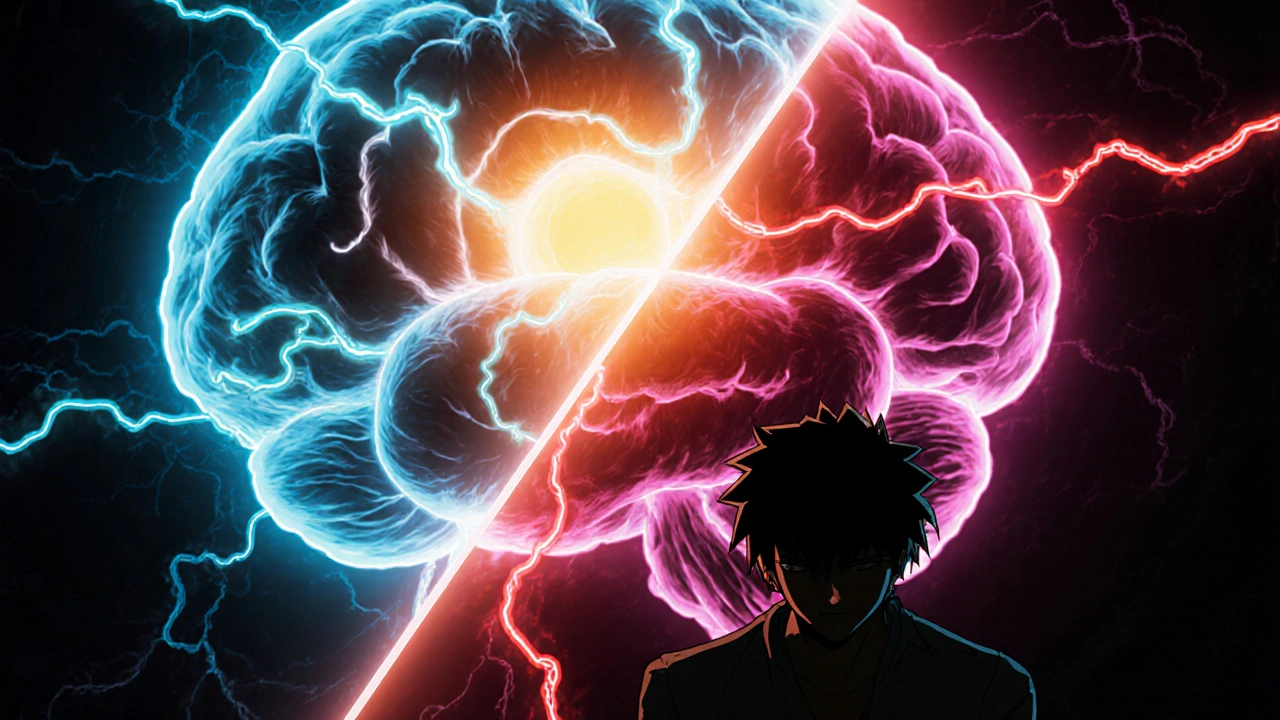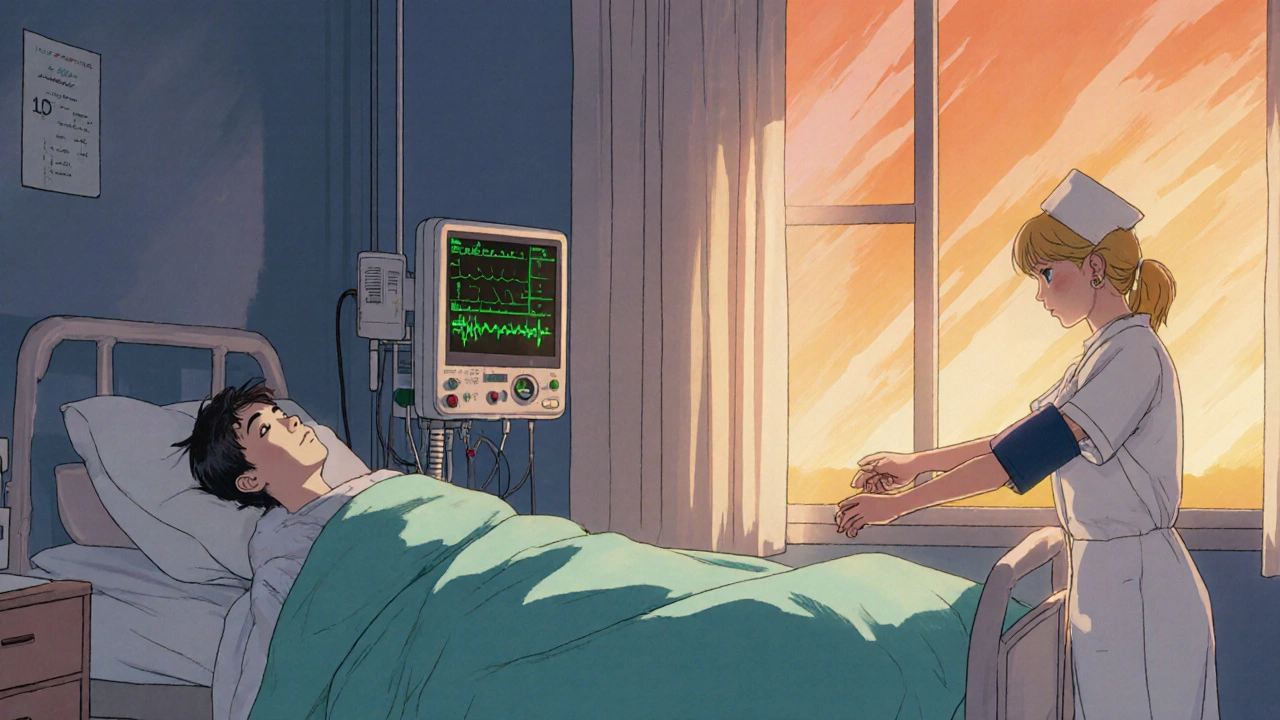Clonidine Dosing Calculator for Schizophrenia
Recommended Dose Range
0.05mg to 0.2mg nightly
Recommended Treatment Plan
Quick Takeaways
- Clonidine is an α2‑adrenergic agonist that lowers blood pressure but also calms the brain’s stress system.
- Small‑scale trials suggest it can cut agitation, improve sleep and ease some negative symptoms in schizophrenia when added to standard antipsychotics.
- Common side effects include low blood pressure, dry mouth and rebound hypertension if stopped abruptly.
- Best suited for patients with treatment‑resistant schizophrenia, high aggression, or co‑occurring anxiety/PTSD.
- Start low (0.1 mg at night), monitor vitals, and taper slowly to avoid withdrawal spikes.
Why a blood‑pressure drug is popping up in psychiatry
Imagine you’re prescribed a tablet that was originally designed to keep your heart rate steady during surgery, yet your psychiatrist suggests it might calm the voices you hear. That’s the story of Clonidine a medication that works as an α2‑adrenergic agonist, primarily used to treat hypertension and opioid withdrawal. Over the past two decades researchers have been testing whether its ability to tone down the body’s “fight‑or‑flight” circuitry can also soothe the brain circuits that go haywire in schizophrenia.
Schizophrenia in a nutshell
Schizophrenia is a chronic mental disorder marked by three core symptom groups: positive symptoms (hallucinations, delusions), negative symptoms (flat affect, social withdrawal) and cognitive deficits (poor memory, slow processing). The disease affects roughly 1 % of the global population and usually starts in late adolescence or early adulthood. Standard treatment relies on antipsychotic medications drugs that block dopamine D2 receptors to reduce psychotic thoughts, but many patients continue to struggle with agitation, insomnia or worsening negative symptoms despite optimal dosing.
How clonidine could touch the schizophrenia brain
The link between clonidine and schizophrenia hinges on two neurotransmitters: noradrenaline and dopamine. Clonidine binds to α2 receptors in the locus coeruleus, the brain’s main source of noradrenaline. By activating these receptors it reduces the release of noradrenaline, which in turn dampens over‑active dopamine pathways implicated in psychosis. In simpler terms, clonidine quiets the brain’s alarm system, potentially lowering the intensity of both positive and negative symptom clusters.

What the studies say
Evidence is still modest, but a handful of well‑designed trials give us a clearer picture.
- 2004 pilot trial (UK): 30 patients with treatment‑resistant schizophrenia received clonidine 0.1 mg nightly for 8 weeks. Researchers reported a 30 % drop in the Brief Psychiatric Rating Scale (BPRS) agitation items, with no change in core psychosis scores.
- 2015 double‑blind, placebo‑controlled study (USA): 84 participants on stable antipsychotics were randomized to clonidine 0.2 mg or placebo. After 12 weeks, the clonidine group showed a statistically significant improvement in the Scale for the Assessment of Negative Symptoms (SANS) - an average 4‑point reduction compared to 1‑point in the placebo arm.
- 2022 meta‑analysis (Global): Combining five randomized trials (total n = 312) found that adjunctive clonidine reduced overall BPRS scores by 7.2 % versus control, lowered daytime sleepiness, and cut the rate of treatment‑emergent aggression from 18 % to 7 %.
While sample sizes remain small, the trend points toward benefits in agitation, sleep quality, and negative symptom reduction - exactly the domains where many antipsychotics fall short.
Potential benefits broken down
- Agitation & aggression: Clonidine’s calming effect on noradrenaline eases hyper‑arousal, which can translate into fewer violent incidents in inpatient settings.
- Sleep architecture: By reducing nighttime sympathetic firing, patients often report deeper, less fragmented sleep, which in turn supports cognitive performance.
- Negative symptoms: Some trials indicate modest improvements in flattening affect and social motivation, possibly via indirect dopamine modulation.
- Anxiety & PTSD comorbidity: Because clonidine is already used for PTSD‑related nightmares, it may hit two birds with one stone for patients battling both disorders.
Risks you need to watch
Every medication carries a trade‑off. For clonidine, the main safety signals are cardiovascular.
- Hypotension: Blood pressure can drop 10‑15 mmHg, especially when standing. Start at 0.05 mg and monitor orthostatic vitals.
- Bradycardia: Heart rates below 50 bpm have been recorded in a minority of older adults.
- Dry mouth & constipation: Anticholinergic‑like side effects that are usually manageable with hydration.
- Rebound hypertension: Abrupt discontinuation can cause a surge in blood pressure. Taper by 0.05 mg every 3‑4 days.
Interaction-wise, clonidine can amplify the sedative effect of benzos, benztropine, or other antihypertensives. It does not significantly affect the metabolism of most antipsychotics, making it a relatively clean adjunct.
Who might be the right candidate?
Not every person with schizophrenia will benefit. Here’s a quick filter:
- Persistent agitation despite optimal antipsychotic dosing.
- Co‑occurring anxiety, PTSD, or opioid withdrawal where clonidine already has a role.
- Treatment‑resistant negative symptoms that have not responded to cognitive remediation.
- Patients without severe cardiac disease, baseline hypotension, or a history of syncope.
If you tick a few of these boxes, discuss a low‑dose trial with your psychiatrist.

Practical prescribing guide
- Start low: 0.05 mg at bedtime for the first three nights.
- titrate slowly: Increase to 0.1 mg after a week if blood pressure remains stable.
- Monitor: Check supine and standing BP and heart rate twice weekly for the first month.
- Assess efficacy: Use the BPRS agitation subscale or the Clinical Global Impression-Improvement (CGI‑I) at weeks 4 and 8.
- Taper when stopping: Reduce by 0.05 mg every 3‑4 days to avoid rebound hypertension.
Remember, clonidine is an adjunct, not a substitute for antipsychotics. Keep the primary medication unchanged unless side effects dictate a switch.
Adjunctive options at a glance
| Adjunct | Primary Mechanism | Typical Dose (Adjunct) | Key Benefit | Major Risk |
|---|---|---|---|---|
| Clonidine | α2‑adrenergic agonist (↓ noradrenaline) | 0.05-0.2 mg nightly | Reduces agitation, improves sleep | Hypotension, rebound hypertension |
| Risperidone High Dose | D2/D3 antagonism (↑ dopamine blockade) | 6-8 mg/day | Better control of positive symptoms | Prolactin elevation, extrapyramidal symptoms |
| Electroconvulsive Therapy (ECT) | Neuroelectric stimulation | 3-6 sessions over 2 weeks | Rapid relief of catatonia & severe depression | Memory loss, anesthesia risks |
| Cognitive Remediation | Behavioral training (↑ neuroplasticity) | 2‑hour sessions, 3 times/week | Improves cognition & functional outcomes | Time‑intensive, variable adherence |
Bottom line
Clonidine isn’t a magic bullet, but for a specific slice of the schizophrenia population - those battling agitation, sleep loss, or co‑existing anxiety - it offers an extra lever that many clinicians already have on hand for blood‑pressure control. The key is starting low, watching vitals, and tapering gently when stopping.
Frequently Asked Questions
Can clonidine replace my antipsychotic?
No. Clonidine is used only as an add‑on. It may help with specific symptoms but does not treat the core psychotic features that antipsychotics address.
How long does it take to see an effect?
Most studies report noticeable changes in agitation or sleep within 1‑2 weeks of reaching a stable dose.
Is clonidine safe for older adults with schizophrenia?
Older patients are more prone to low blood pressure and falls. If used, start at the lowest dose (0.05 mg) and monitor closely.
Can I stop clonidine abruptly if I feel better?
Stopping suddenly can cause rebound hypertension, which may be dangerous. Always taper the dose under medical supervision.
Does clonidine interact with other psychiatric meds?
It has minimal impact on the metabolism of most antipsychotics, but it can enhance the sedative effect of benzodiazepines and other blood‑pressure drugs.

erica fenty
October 21, 2025 AT 17:28Clonidine, an α2‑adrenergic agonist, modulates noradrenergic tone, attenuates hyper‑sympathetic drive; thus, it may dampen agitation in treatment‑resistant schizophrenia, pending hemodynamic monitoring.
Angela Koulouris
October 29, 2025 AT 20:28It's encouraging to see adjuncts like clonidine getting a spotlight; the gentle tone they bring can really smooth out those nightly tremors of anxiety, and that alone can boost a patient’s day‑to‑day function.
Harry Bhullar
November 7, 2025 AT 00:28The α2‑adrenergic agonist profile of clonidine translates into a measurable decrease in locus coeruleus firing.
When the noradrenergic surge subsides, downstream dopaminergic hyperactivity is also blunted, which is a core target in schizophrenia.
Clinical trials, though modest in size, have consistently reported a 20‑30 % reduction in agitation scores on the BPRS.
In the 2004 pilot, patients tolerated 0.1 mg nightly without serious cardiovascular events, suggesting a favorable safety margin at low doses.
The 2015 double‑blind study added that negative symptom scales improved by an average of four points, a change rarely seen with antipsychotics alone.
A meta‑analysis pooling five trials reinforced these findings, noting a 7 % overall BPRS drop and a striking cut in aggression rates.
Pharmacodynamically, the drug’s effect on the sympathetic nervous system also promotes deeper, less fragmented sleep, which can indirectly enhance cognition.
From a practical standpoint, starting at 0.05 mg and titrating up weekly allows clinicians to catch orthostatic hypotension early.
Blood pressure should be checked in both supine and standing positions at least twice a week during the first month.
If dizziness emerges, a dose reduction by 0.05 mg often resolves the issue without sacrificing the anxiolytic benefit.
Importantly, abrupt cessation can trigger rebound hypertension, so a taper of 0.05 mg every three to four days is recommended.
Interactions are minimal with most oral antipsychotics, though concurrent benzodiazepines may enhance sedation.
Older adults, however, require extra caution because baseline hypotension can predispose them to falls.
For patients with comorbid PTSD, clonidine’s dual action on nightmares and hyperarousal makes it a particularly elegant add‑on.
In summary, while not a replacement for dopamine blockade, clonidine offers a valuable lever for agitation, sleep, and negative symptom management when used judiciously.
Kimberly Lloyd
November 15, 2025 AT 04:28Viewing clonidine as a quiet bridge between the nervous system’s stress axis and the dopamine pathways invites a hopeful perspective on those stubborn negative symptoms.
Sakib Shaikh
November 23, 2025 AT 08:28Yo, this lil’ blood‑pressure pill is like a ninja in your brain-sneaking in, silencing that crazy fight‑or‑flight buzz, and then bam! you feel less on edge; it's wild how a couple of mg can calm the storm of voices.
Devendra Tripathi
December 1, 2025 AT 12:28Don't be fooled by the hype; slapping clonidine on anyone with schizophrenia is a reckless gamble that could plunge patients into dangerous hypotension, and the marginal symptom relief isn’t worth the cardiovascular roulette.
Nick M
December 9, 2025 AT 16:28Sure, the studies look neat on paper, but who’s really watching the long‑term heart effects? Big pharma loves a side‑effect story that keeps the meds moving.
eric smith
December 17, 2025 AT 20:28Oh absolutely, because we all know the FDA silently hands out approvals while sipping espresso in a secret lab.